Live on the homepage now!
Reader Supported News
What occurred at one Starbucks store is part of a much larger pattern — a surge in strikes and labor actions across America
The vote itself was tiny. There were 19 baristas and shift supervisors who voted in favor of unionizing, 8 voted against. But it marked a huge victory, nonetheless. Starbucks had waged a massive anti-union campaign in Buffalo — sending out-of-town managers and even executives into stores to discourage unionizing, closing down some stores, and packing remaining stores with new employees in order to dilute pro-union employees’ voting power.
For years, Starbucks workers have complained about the company’s labor practices, claiming that chronic understaffing has created a chaotic work environment, unpredictable hours, and difficulty in taking sick days. Despite episodic commitments by Starbucks management to change, the complaints have continued. They intensified during the pandemic when overstretched Starbucks employees had to deal with new health risks and safety protocols.
The union election marks one of the highest-profile union wins in memory for US restaurant workers, who are among the least unionized in the country and whose pay and benefits are among the lowest in all of corporate America. It’s certain to encourage more unionizing efforts among workers in restaurant chains.
What occurred on Thursday at one Starbucks store is part of a much larger pattern — a surge in strikes and labor actions across America.
Kellogg’s striking workers are still holding the line and refusing to allow the company to separate employees into tiers (with newer workers getting lower pay and benefits). Amazon warehouse workers in Bessemer, Alabama will get another chance to unionize (the National Labor Relations Board found that Amazon used unfair labor practices in the recent election there). And 3,000 student workers at Columbia University have been on strike for six weeks to demand better pay and health care (on Monday, at least 100 members of the Columbia faculty joined them on the picket line).
What’s going on? Partly, low-wage workers have more bargaining leverage now than they’ve had in years. As the pandemic recedes (let’s hope it continues to), consumers are spending at a higher rate than they have in over twenty months. To respond to this surge in pent-up demand, employers are seeking workers.
At the same time, workers across America are taking a fresh look at their jobs. Record-high “quit” rates and near record low rates of labor-participation suggest that a significant number are asking themselves if they want to go back to their old jobs — and are answering “no.”
Part of the “no” is an unwillingness to settle for their former wages and working conditions — especially in big companies (like Starbucks, Amazon, and Kelloggs) whose profits have been sky-high. (Or even in richly-endowed universities like Columbia.) That “no” is also reverberating across America in the form of strikes.
Many of these workers were on the front lines in the pandemic, and now feel it’s time for their efforts to be rewarded. At a deeper level, I suspect the pandemic itself has caused many people to reevaluate what they’re doing with their lives and to set different priorities for themselves.
For years, many big corporations like Starbucks have sold themselves as “socially-responsible” — offering consumers the soothing reassurance that in buying their products they’re somehow advancing the common good. That was always bullshit. Corporations exist only to make money. Corporate social responsibility is a jejune form of public relations. Starbucks’s aggressively marketed “socially responsible” business model turns out to be no different.
When corporations like Starbucks fight their workers’ legal right to form a union, the PR veil is lifted for all to see what’s really going on. Starbucks calls its workers “partners,” but they’re not in fact partners. They don’t share in the firm’s profits.
Between January and September of this year, Starbucks’s revenue soared to $20.9bn — compared to $17.3bn in the same period last year. Its president and chief executive officer, Kevin Johnson, made $14,665,575 in total compensation last year and is on the way to getting a far larger package this year. Yet current average hourly pay at Starbucks is $14, or $28,000 a year.
It’s all about power — the power of workers to join together to gain the bargaining clout they need for better pay and working conditions, up against corporate power to keep wages so low that shareholders and executives can make even more. The victory at one Starbucks store in Buffalo, New York, is a small step on the long road toward rebalancing such power.
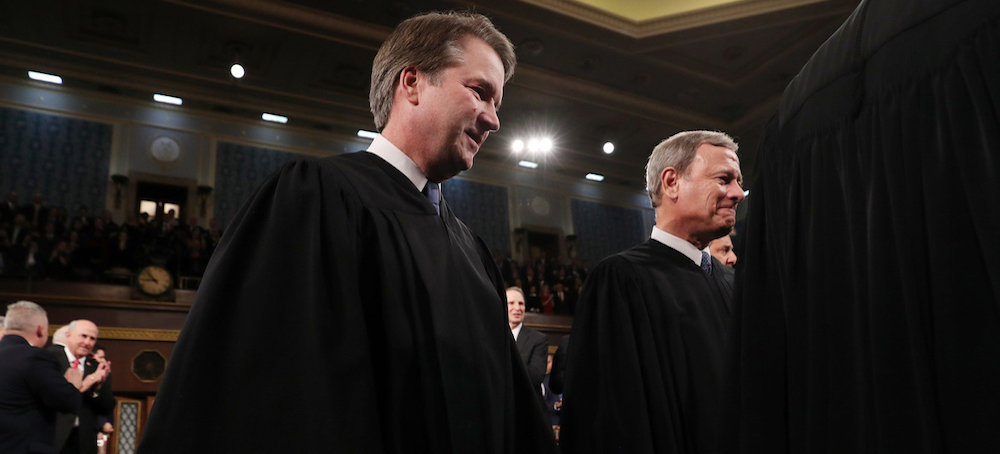 Justice Brett Kavanaugh and Chief Justice John Roberts. (photo: Getty Images)
Justice Brett Kavanaugh and Chief Justice John Roberts. (photo: Getty Images)
In a strongly worded opinion joined by the high court’s three liberal justices, Roberts wrote that the "clear purpose and actual effect" of the Texas law was "to nullify this Court’s rulings." That, he said, undermines the Constitution and the fundamental role of the Supreme Court and the court system as a whole.
The opinion was a remarkable plea by the chief justice to his colleagues on the court to resist the efforts by right-wing lawmakers to get around court decisions they dislike, in this case Roe v. Wade, the 1973 decision that made abortion legal in the United States, within limits. But in this case, his urgent request was largely ignored by the other justices on the court who were appointed by Republicans.
His point to them was that the court system should decide what the law is, and it should resist efforts like that of the Texas Legislature to get around the courts by limiting the ability of abortion providers to sue.
It is a basic principle, he wrote, "that the Constitution is the 'fundamental and paramount law of the nation,' and '[i]t is emphatically the province and duty of the judicial department to say what the law is.'" He cited as proof the landmark 1803 Marbury v. Madison case, which established the principle of judicial review, allowing the court to nullify laws that violate the Constitution.
“If the legislatures of the several states may, at will, annul the judgments of the courts of the United States, and destroy the rights acquired under those judgments, the Constitution itself becomes a solemn mockery,” he said, quoting the 1809 U.S. v. Peters case, which found that state legislatures can't overrule federal courts. “The nature of the federal right infringed does not matter; it is the role of the Supreme Court in our constitutional system that is at stake.”
The Texas law, which took effect in September, delegates enforcement to any person, anywhere, who can sue any doctor performing an abortion or anyone who aids in the procedure. That makes it virtually impossible for abortion providers to sue the state to block the law, S.B. 8. Texas has argued that the law's opponents had no legal authority to sue the state because S.B. 8 does not give state officials any role in enforcing the restriction.
Roberts has said that politics has no place at the Supreme Court and has made it clear he will resist efforts to draw the court into partisan cultural fights, fearing that the perception of partisanship will undermine the court's legitimacy.
With the court now having a 6-3 conservative supermajority, Roberts wound up siding with the three liberal justices: Elena Kagan, Stephen Breyer and Sonia Sotomayor. The addition of three justices by former President Donald Trump meant Roberts could not find another vote for his position, leaving him largely in the minority in the abortion ruling.
Melissa Murray, a law professor at New York University, said Friday on MSNBC that “the real question here is whether or not Chief Justice John Roberts is chief justice in principle as well as name.”
“The question here is how can he rein in that hardcore conservative bloc of the court?" she asked. "And it seemed obvious last week in oral arguments, and this week — in terms of how these opinions are written, and where the chief justice finds himself — that maybe he's having a hard time keeping all of the conservative bloc in line.”
The Supreme Court ruling Friday said that abortion providers in Texas can move forward with their lawsuit challenging S.B. 8 along a very narrow path. But it kept the law in effect while the court battle unfolds, which abortion rights supporters said would prevent large numbers of low-income Texas women from obtaining abortions during the legal fight.
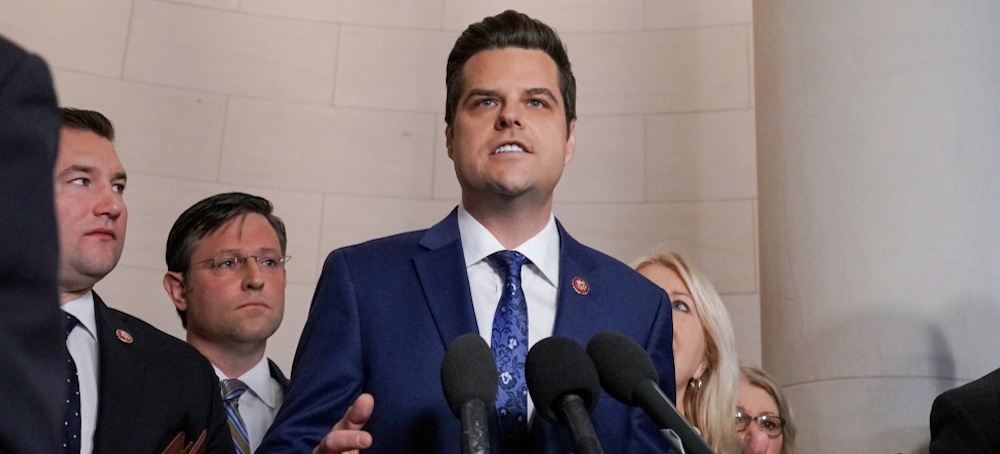 Matt Gaetz. (photo: Jemal Countess/Redux)
Matt Gaetz. (photo: Jemal Countess/Redux)
During Thursday's episode of Bannon's "War Room" podcast, he and Gaetz outlined their plan if Trump should win.
Trump has not yet publicly announced he is running in 2024.
"People didn't like that Donald Trump raised his voice, but sometimes you gotta raise your voice to raise a ruckus and to raise an army of patriots who love this country and will fight for her," Gaetz said.
"We're going to operationalize the performance to go right after the people who are imposing the vaccine mandates, who are enriching themselves, and who are selling out the country," Gaetz added.
Bannon then went on to suggest to a nodding Gaetz that there should be a "theory of governing" before elaborating on what his plan would be if Trump were to be president again.
"It's fresh and it's new. This is Trumpism in power. That's when we went to the 4,000 shock troops we have to have that's going to man the government. Get them ready now. Right?" Bannon said. "We're going to hit the beach with the landing teams and the beachhead teams and all that nomenclature they use when President Trump wins in 2024 — or before."
Bannon went on to suggest that these 4,000 shock troops would then become "political appointees."
"On Capitol Hill, you're going to have Gaetz, and others," Bannon said. "No more powderpuff derby. This is going to be hardcore accountability at every committee."
"And we're going to go after this administrative state and we're going to start at the Department of Justice and the FBI. That's the job I want. You know, send me over to the Judiciary Committee and their sphincters will tighten because they have been doing a lot of corrupt things over there," Gaetz said in response to Bannon's suggestion.
It is unclear what Gaetz and Bannon meant, specifically, with references to an "army of patriots" and "shock troops."
Gaetz responded to Insider's request for comment with a tweet implying his remarks were a metaphor and claiming the reporter was being "a tad literal" about his comments.
Representatives for Bannon did not immediately respond to a request for comment from Insider.
In October, Bannon made a similar, albeit less detailed suggestion when calling into NBC News.
"If you're going to take over the administrative state and deconstruct it, then you have to have shock troops prepared to take it over immediately," Bannon said. "I gave 'em fire and brimstone."
In November, Bannon appeared in court to face criminal contempt charges for defying a subpoena to sit for a deposition and produce documents related to the January 6 Capitol riot. The former White House chief strategist faces two criminal contempt-of-Congress charges, and his trial date is set for July 18.
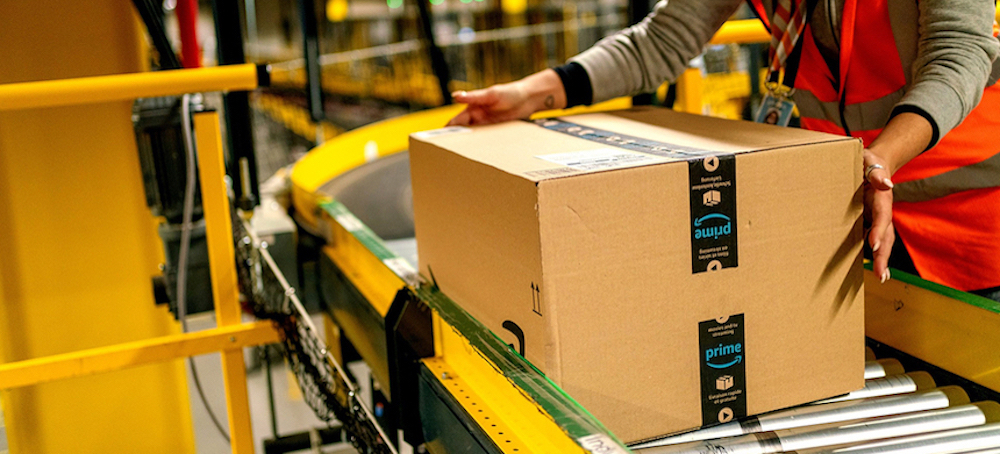 A worker collects a package from a conveyor at an Amazon fulfillment center. (photo: Thorsten Wagner/Bloomberg)
A worker collects a package from a conveyor at an Amazon fulfillment center. (photo: Thorsten Wagner/Bloomberg)
A new report finds that Amazon warehouses in Minnesota have more than double the injury rate of non-Amazon warehouses, with a sky-high turnover rate and black workers making far less than their white counterparts.
The numbers show that the injury rate at Amazon warehouses from 2018 to 2020 is 11.1 per 100 workers, more than double the rate of 5.2 per 100 at non-Amazon warehouses in the state (and more than four times as high as the state’s rate for the average private industry worker). These numbers come from the 792 OSHA reports filed during the period.
Many of those injuries are musculoskeletal disorders that follow from the repetitive lifting required by Amazon warehouse work, with high quotas and inflexible enforcement. These are injuries that linger, sometimes for the rest of a worker’s life. As one worker says in the report, his hands go numb by the end of his shifts.
A 2019 investigation showed that Amazon had an injury rate of 9.6 per 100 workers, more than double the industry average of 4 per 100. While more recent numbers suggested a reduction in that rate, this latest report shows that at least at some facilities, there has been little if any change.
Amazon opened its first major fulfillment center in the state in Shakopee five years ago, and it has since added another in Lakeville. The company says it has invested more than $3 billion into Minnesota over the past decade. The report finds that in 2020, no industry in the state had a higher average rate of injury than the original Shakopee Amazon fulfillment center.
The Shakopee facility, known as MSP1, relies heavily on the local East African immigrant population to staff its operations, and the report finds that such workers are paid significantly less than their white counterparts in the state’s warehouse industry. Black workers constitute 38 percent of the warehouse workforce in Scott County, where Shakopee is located — the report’s authors note that most warehouses in the county are Amazon facilities. These workers constitute only 8 percent of the Twin Cities’ workforce. According to Census data from 2018, these black workers made 63 percent of white warehouse workers’ monthly wages — $2,108 compared to $3,339.25.
While Amazon often boasts of its high starting wages — the company instituted a $15-an-hour wage in 2018, following pressure from the likes of Senator Bernie Sanders, and in the current tighter-than-usual labor market, has pushed that number higher at many facilities — Amazon entering a county continues to lower wages at nearby warehouses. The report finds that real wages for warehouse workers declined 14 percent from 2015 to 2018, after MSP1 began operating.
At Shakopee, annual turnover in recent years has been as high as 170 percent, compared to 61 percent turnover at the state’s non-Amazon warehouses. This is in accord with a recent New York Times investigation that found 150 percent turnover at other Amazon facilities.
MSP1 has also been the site of organizing by Amazon workers themselves, often assisted by the Awood Center, which particularly focuses on improving working conditions for East African immigrants. In 2018, MSP1 workers became some of the first Amazon workers in the United States to convince the company to negotiate over productivity quotas that did not leave Muslim workers adequate time for prayer. Early last year, MSP1 workers walked off the job to protest the firing of a coworker; she was successfully reinstated. They did the same a few months later, this time to protest retaliation against a worker who spoke up about the need for additional health and safety precautions during the pandemic.
That kind of organizing will be crucial for Minnesota Amazon workers trying to push back against the untenable conditions outlined in the report. The authors’ recommendations include a statewide OSHA investigation into the company’s facilities, an investigation into and overhaul of Amcare (Amazon’s on-site emergency care), firmer mandates for rest periods, and a ban on the company’s oblique productivity quotas that govern every second of workers’ “time off task.” The latter might look something like AB 701, the recently passed California bill that requires warehouses to disclose productivity quotas to workers in writing and attempts to strengthen protections for workers who are disciplined for failing to meet such quotas because they took standard meal and bathroom breaks.
It’s a strong legislative agenda that can only be carried out with workers themselves organized inside the warehouses to monitor enforcement of such measures, holding contracts that upend Amazon’s dictatorial control over their every movement. That company control is what creates the intolerable, dangerous pressure that leads to such high injury rates, and ultimately forces many workers to leave Amazon jobs within weeks, before much of anything can change.
 Mother and baby manatees at Three Sisters Springs in Crystal River, Florida. (photo: James R.D. Scott/Moment/Getty Images)
Mother and baby manatees at Three Sisters Springs in Crystal River, Florida. (photo: James R.D. Scott/Moment/Getty Images)
Record numbers of endangered manatees are dying as polluted waters kill off their food sources
Typically, manatees return to warm water winter feeding grounds, where they feast on plentiful seagrass.
But algal blooms from polluted waters have devastated seagrass beds, and thereby wiped out the important food source for the manatees. Algal blooms and manatee deaths have been especially pronounced along Florida’s Atlantic coast, leading to record-breaking mortality.
“Our agencies and Unified Command partners carefully considered all aspects of a short-term feeding trial,” said Shannon Estenoz, assistant secretary for Fish and Wildlife and Parks with the federal Department of Interior, in a release. “It is critical we help manatees in the short term with actions that are compatible with their long-term wellbeing and resilience.”
Normally slow-moving and plump, manatees along Florida’s east coast have shown signs of starvation, and appeared emaciated with protruding ribs. Manatee deaths have overwhelmed local rescue groups and even the ecosystem.
Hundreds of manatee carcasses have had to be towed to remote islands, where they have been left to rot, the Palm Beach Post reported.
“They are starving, and I see it in person,” Paul Fafeita, president of the Clean Water Coalition of Indian River county, told local television station CBS12 in Palm Beach. “I’m out there all the time. I’m witnessing it. It’s heart wrenching.”
As a result, Florida and federal government wildlife officials said they would begin an operation to hand-feed manatees romaine lettuce, among other efforts.
A temporary field response station is also expected to be set up in the Indian River Lagoon, on the coast near Orlando, where many deaths have occurred. The Florida state legislature increased an annual stipend for manatee rescue to $8m.
Initial 2021 manatee mortality data from the state’s conservation department showed more than 1,000 manatees have died. Manatees are an endangered species. The most recent aerial survey of Florida manatee populations found only about 5,700 in Florida, according to Save the Manatee. In the last five years, an average of 500 manatees have died. By comparison in 2001, just 325 manatees were found dead, with boats among their biggest killers.
 Indigenous protesters in Colombia. (photo: Federico Rios/NYT)
Indigenous protesters in Colombia. (photo: Federico Rios/NYT)
”We want to send a message to the country and the world: we ask them to listen to us because there is a lot of massacres in the Cauca Valley,” CRIC activist Tote said.
They left Popayan yesterday afternoon to arrive in this city on Human Rights Day on Dec. 10, when the Indigenous communities plan to carry out various peaceful acts to demand respect for their people and lands. Among the problems that most affect them are the forced recruitment of minors and the murder of social leaders, as reported by Hernan Tobar, the correspondent for teleSUR.
“We want to send an invitation to reconciliation to the population of Cali. In our region many cultures converge and we want peace for all,” Regional Indigenous Council of Cauca (CRIC) Advisor Ancizar Marin said, adding that they ask the Duque administration to resume the Peace talks.
Previously, Cauca Valley Governador Clara Roldan asked the Defense Ministry to deploy troops to prevent acts of violence during the arrival of the Indigenous mobilization to Cali.
The tweet reads, “It is a Mestizo, Indigenous, and Afro party! It is a multicultural, multiethnic party. A party in peace with brotherhood and joy."
This request occurred because some urban sectors opposed the presence of the indigenous population in the city, arguing that social organizations generated incidents during the National strike that occurred between April and May.
In response to these criticisms, CRIC Political Commission member Dario Tote said that the mobilization only aims to denounce the violations against the rights of Indigenous peoples.
"Our march is peaceful... No blockades or activities against public order have been scheduled. We want to send a message to the country and the world: we ask them to listen to us because there is a lot of massacres in the Cauca Valley,” he said, reiterating that they are protesting the presence of any armed actor in their territories.
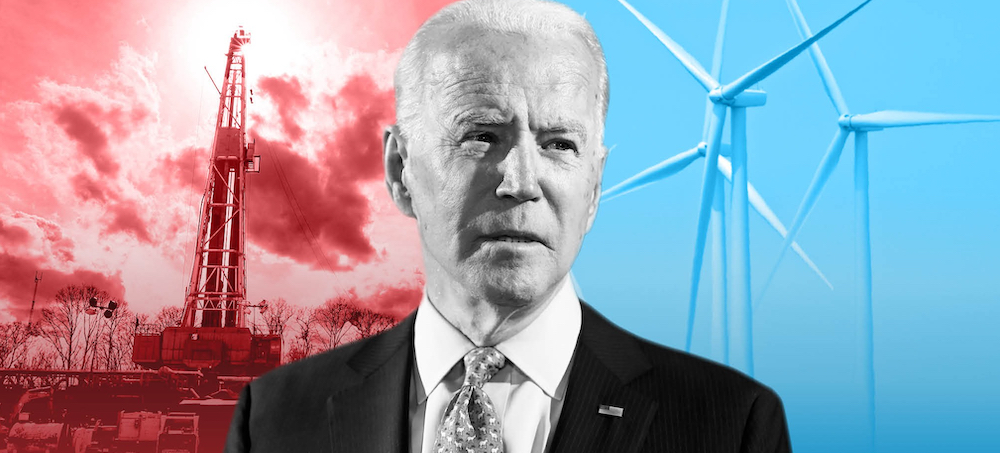 "Biden set new goals for the government to cut its carbon dioxide emissions by 65 percent by the end of this decade and to zero out federal emissions by 2050." (image: FT)
"Biden set new goals for the government to cut its carbon dioxide emissions by 65 percent by the end of this decade and to zero out federal emissions by 2050." (image: FT)
The president aims to leverage the federal government’s massive buying power to jump-start the market for clean energy, electric vehicles and more efficient buildings.
In an executive order he Biden Wednesday, Biden set new goals for the government to cut its carbon dioxide emissions by 65 percent by the end of this decade and to zero out federal emissions by 2050.
The order puts the U.S. in line with global targets to reach net-zero carbon emissions by the middle of the century, which scientists say is needed to reduce the effects of climate change.
Biden’s order also establishes a “Buy Clean” policy, directing the federal government to use lower-emissions construction materials. It calls for the government to use 100 percent clean electricity by 2030.
“The executive order will reduce emissions across federal operations, invest in American clean energy industries and manufacturing, and create clean, healthy, and resilient communities,” the White House said.
Biden was visiting a transportation center in Kansas City on Wednesday, the latest stop of a tour to promote the $1.2 trillion bipartisan infrastructure law.
After he toured the transit depot, Biden cast a spotlight on how commuters and people who rely on buses, trains and ferries will benefit from $39 billion in new funding to modernize public transit.
The order is the Biden administration's latest effort to speed the economy’s broader transition from fossil fuels and grow the marketplace for cleaner technologies.
As the country’s largest employer, the federal government has about $650 billion in annual purchasing power for goods and services, the White House said. That makes the government and its purchasing plans significant factors for businesses and manufacturers looking for lucrative contracts as they decide what products to offer.
The White House hopes that as manufacturers scale up production of clean technologies to meet the government’s future needs, the cost of such products and services will decrease, making them more affordable for families and businesses in the private sector.
The government intends to spend tens of billions from the bipartisan infrastructure law and the Build Back Better Act, if it passes, to replace its 600,000 cars and trucks with an all-electric fleet, as well as upgrade efficiency in its 300,000 buildings.
Biden’s order pledges that light-duty vehicles purchased by the government will be zero-emission by 2027 and says all vehicles should meet the standard by 2035.
In his remarks in Missouri, Biden highlighted how modern public transit, including electric buses, has been helping Kansas City meet its emissions goals and will play a role for communities tackling climate change in the future.
Follow us on facebook and twitter!
PO Box 2043 / Citrus Heights, CA 95611

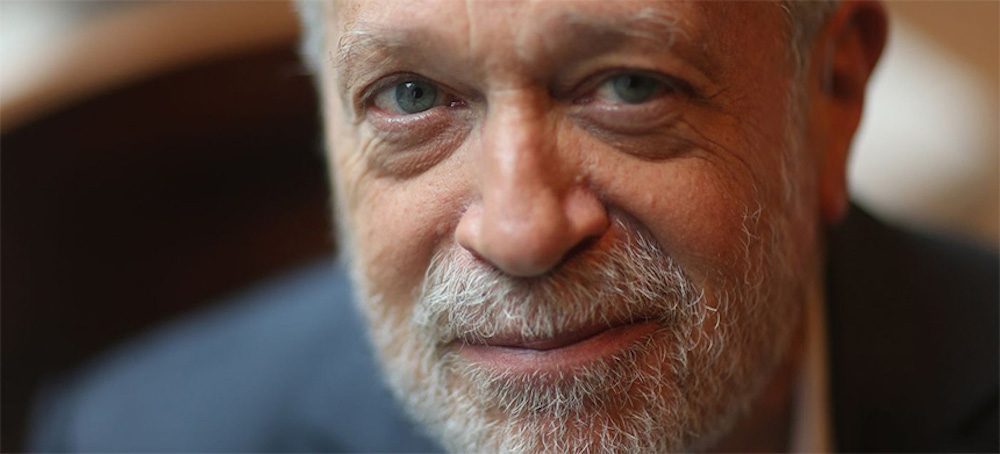

No comments:
Post a Comment